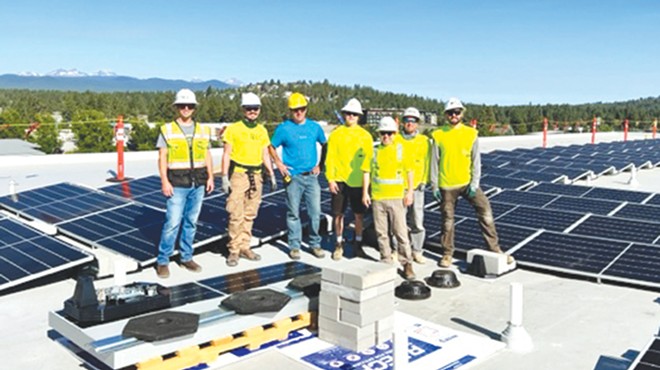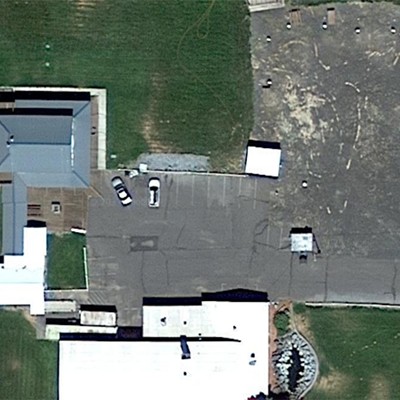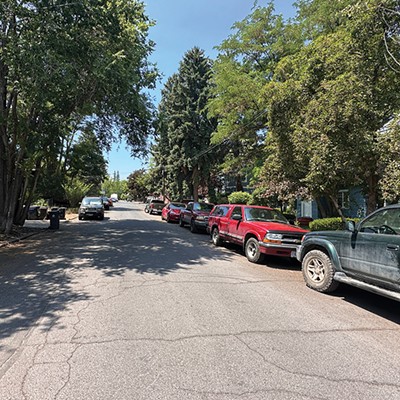Oregon set ambitious climate goals in June 2021, seeking to fully eliminate carbon emissions from the state's electrical grid by 2040. It's the fastest decarbonization timeline for a power grid in the United States. The Oregon Department of Environmental Quality found electricity use contributes nearly 30% of emissions in the state, second only to transportation.
Coal and natural gas accounted for more than 98% of greenhouse gases from power generation. Oregon deactivated its last coal-fired powerplant in 2020, but still uses out-of-state coal power. In 2020 coal produced 27% of Oregon's total power use, and accounted for 75% of the state's greenhouse gases from electricity, according to the Oregon Department of Energy. The state uses about 7% more coal and about half as much natural gas as the national average. Hydropower is the biggest producer of electricity in the state at about 39%, but the use of solar and wind fall behind national averages.
Solar Power
Oregon's solar projects are largely made up of independent brokers who sell energy to larger providers or electricity co-ops. Only about 1.5% of the state's power comes from solar energy, but the state is hoping to expand on that. Senate Bill 1547 established a program to produce 160 megawatts between Oregon's two biggest utility companies, Pacific Power and Portland General Electric. That's enough energy to power about 64,000 homes.
"The intent of the program was to add to Oregon's renewable energy mix, and also to make solar energy available to consumers across the state who previously did not have access," said Sean Micken, partnerships manager for Oregon Shines, a project manager for community solar subscriptions.
Oregon Shines offers an alternative to renewable programs offered directly from utilities. Pacific Power's Blue Sky program has attracted more than 148,000 participants, who pay a couple extra bucks a month to get power from wind, solar, geothermal and low-impact hydropower from over 50 facilities scattered across the West. Oregon Shines differs from the Blue Sky program by focusing just on solar power and guaranteeing savings on the power bill.
"When you sign up for the Blue Sky program, there's a line item that says Blue Sky energy; you pay about one cent per kilowatt hour extra to get your energy from the program. With the community solar program, you're actually getting a half cent per kilowatt hour savings on your bill," Micken said.
Oregon Shines is the only subscription manager currently enrolling Pacific Power customers in the Oregon Community Solar Program. There are currently six solar farms that it's booking to residential and commercial clients.
"This is a way of, I would say, directing your support towards more local, selective projects, and developers and owners which are all new, essentially," Micken said.
The program is marketed to people who can't put up solar panels on their homes. Solar panels aren't a good investment if a homeowner's roof is facing north/south, if it's not structurally fit to support solar panels or if trees provide shade. Senate Bill 1547 also stipulates 10% of community solar clients are low-income, and they're eligible for discounts that can significantly reduce their electric bill.
"If you're an individual and making under about $41,000 per year, you qualify. If you're a household of four and make $80,000 or less per year, that makes you eligible for a 40% discount on your subscribed energy," Micken said.
Paying less for the same amount of energy is possible thanks to federal tax credits for investors and owners of solar projects, and the relatively low cost of maintaining renewables after large startup costs.
"If you look at the cost of energy, and where your utilities are buying low-cost energy, some of the least expensive energy on the grid today is from renewables," Micken said. "Your average megawatt hour from a wind energy project is typically less than your average megawatt hour from a new gas or coal facility."
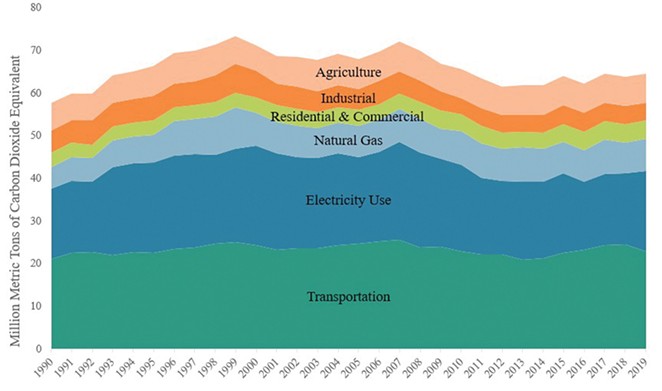
The Grid
Though solar is expanding, hydropower is the biggest contributor to the state's electrical grid. Hydropower is about 40% of Oregon's total fuel for the state, much of it supplied from the Bonneville Power Administration — a federal agency in the Pacific Northwest that controls 31 dams and one nuclear power plant.
"We're lucky to have a lot of hydropower, which is reliable. It changes seasonally a little bit with how much rainfall there is, but mostly we can count on it powering our grid through most of the year," said Paul Kempler, a professor and researcher at the University of Oregon studying electrochemistry and its applications to decarbonization. "Our grids are very, very clean because of that hydropower."
The largest power providers, Pacific Power and Portland General Electric, are less reliant on hydro. About 50% of Pacific Power's energy comes from coal and 19% from natural gas. A little over 20% of its energy is sourced from renewables like wind, solar and hydro. Forty-seven percent of Portland General Electric's power comes from coal and natural gas. That's unlikely to last long with the emission caps put in place by the legislature. Both companies supported the bill and set their own climate goals that aren't much different than those set by the state.
"There's a reason [Pacific Power owner] Warren Buffett went big on solar. He's a smart guy, and he realizes that the world is changing. Our priorities as a country are changing," Micken, of Oregon Shines, said. "It's not like we're going to do away with coal and natural gas anytime soon. But we've got to balance it out with some of these other low-cost, low-carbon, predictable fuel and energy supplies. Solar, I would say, checks all those boxes."
Outside of the two power giants are dozens of small energy co-ops that mostly rely on the Bonneville Power Administration. About 85% of BPA's power comes from hydroelectric dams, 10% from nuclear power and less than 5% is purchased from other providers.
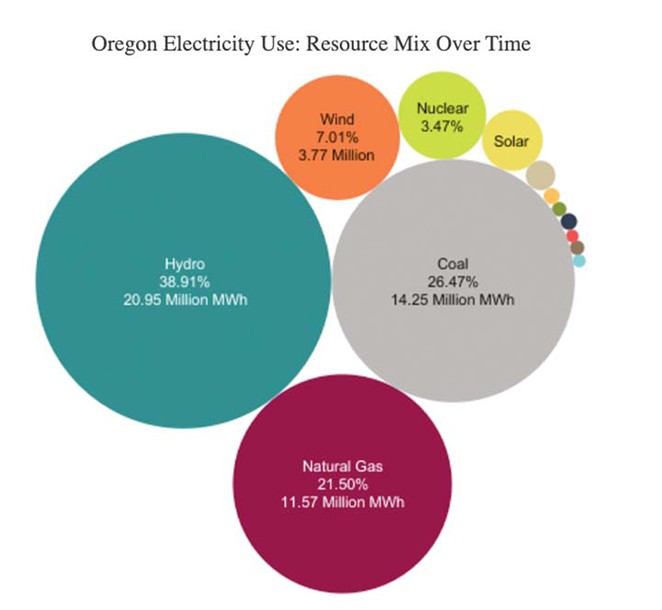
Looking Forward
Green energy is being propelled by simple economics. In the past 10 years green technology has gotten cheaper. The cost of solar power dropped 90% over the past 10 years, according to the Levelized Cost of Energy Report. Similarly, the lifetime cost of new wind farms dropped by 71% in the past decade.
"We consistently underestimate the ability of wind energy and solar energy, and now batteries, to become cheaper. There's pretty well understood scaling relationships that say as you build this many batteries or this many solar panels that it will become cheaper by this fraction," Kempler, the professor, said.
Energy storage is crucial for power grids that don't have access to the reliable hydro power Oregon has. California installed around 4,400 megawatts of energy storage with lithium-ion batteries, according to the nonprofit California Independent System Operator. The state will need storage to keep the lights on when the sun isn't shining, and the wind isn't blowing.
"These batteries are actually being used to shift about two hours to four hours of energy every single day. There's a point in the middle of the day where there's a ton of sunlight in California, and they have plenty of solar energy, but that's not actually when the grid uses the most energy," Kempler said. "The grid uses a lot of energy around 6-7pm, when people get home and turn on their stoves, turn on their dryers."
Lithium-ion is going through the same process as solar panels and wind energy — they're finally cheap and durable enough to be used for grid-scale energy storage. But in Oregon the "batteries" take the form of dams and reservoirs, where water can be released at will to respond to demand.
"Because we're able to ramp the power production on the dams up and down, we don't need a lot of grid storage, and haven't had to deploy the same amount of battery storage that California has," Kempler said.
Some people worry that the full electrification of the power grid could lead to instability. Kempler said that as more resources like wind and solar are added, a system has to be put in place to distribute energy where it's needed.
"I think the rhetoric that it's the emissions goals that are going to make our grids unstable, is interesting, because we have lots of evidence in the last couple of years of grids that have failed, because the fossil resources on those grids — natural gas turbines, coal plants, failed during weather emergencies," Kempler said. "I don't know that we have a clear apples-to-apples comparison of any electricity grids that have been built or that are up being upgraded to say it's clear that it's the wind and the solar energy that are causing reliability issues."



